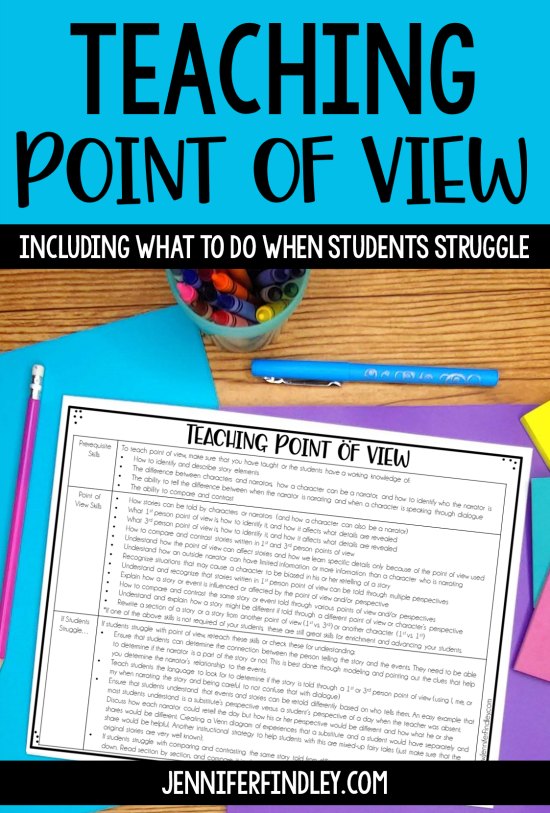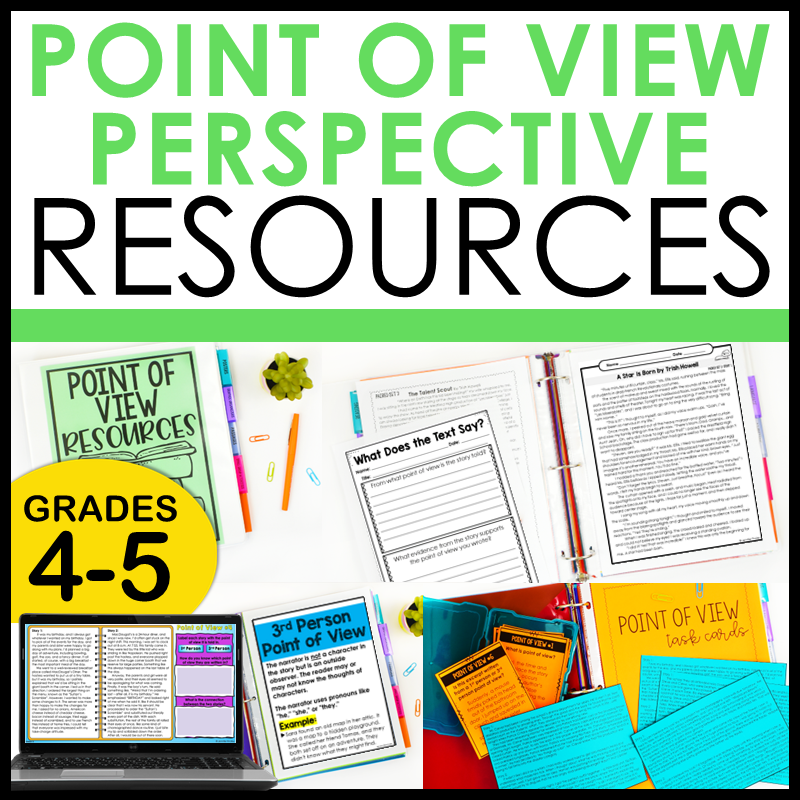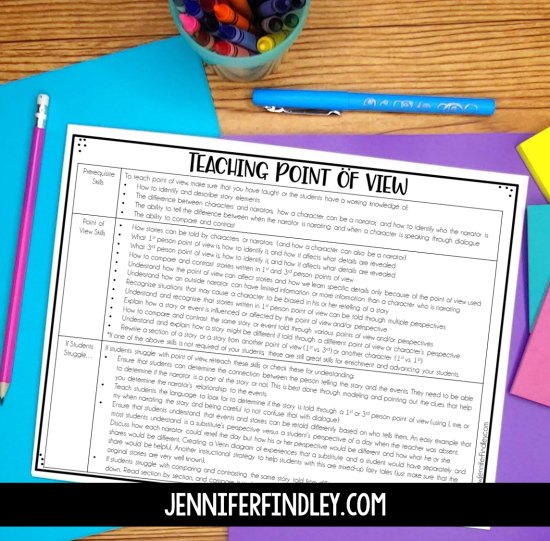Teaching point of view and perspective is another tricky reading skill for 4th and 5th grade readers. On this post, I will share tips to help you teach point of view to your students, including what skills students need before instruction on point of view, all of the different point of view subskills that really increase the rigor, and strategies that you can do when students struggle.

Point of View and Perspective – Two Tricky Terms
There are several differing definitions for point of view and perspective that you will find. After doing my own research, here is how I define them for myself and for my students (I do make sure my students understand that they may be used interchangeably as well).
Point of View – how the story is told…is it told through a 1st person point of view via a character or a 3rd person point of view via an outside narrator?
Perspective – the perspective through which the events are told. For example, a story written in 1st person point of view can have multiple perspectives depending on which character is retelling the events. We are told the events through that person’s perspective so I directly connect perspective with who is telling the story and what their relation and connection is to the events.
A lot of people define perspective as how the narrator views the events, like their opinion or viewpoint, so I do expose my students to that as well.
I know that can be tricky but I think students are able to understand both after lots of instruction and exposure and using the terms interchangeably doesn’t affect them too much.
Pre-Requisite Standards Before Teaching Point of View
To teach point of view, make sure that you have taught or the students have a working knowledge of:
- How to identify and describe story elements
- The difference between characters and narrators, how a character can be a narrator, and how to identify who the narrator is
- The ability to tell the difference between when the narrator is narrating and when a character is speaking through dialogue
- The ability to compare and contrast
Point of View Skills Students Need to Master
Point of view skills really vary from 4th to 5th grade. 5th grade really ups the rigor and requirement. However, when I teach 4th grade students, I try and teach it a bit more rigorously to the ones who are ready.
If you teach 4th grade, keep this in mind when looking at the list of point of view skills. Only about half apply to your grade level. 5th grade teachers, on the other hand, may have to teach all of the skills (even the ones required by 4th because we know that retention is not always something that goes in our favor.)
Here are all the subskills to really teach point of view (and perspective since they go hand-in-hand) to the rigor most states require:
- How stories can be told by characters or narrators (and how a character can also be a narrator)
- What 1st person point of view is, how to identify it, and how it affects what details are revealed
- What 3rd person point of view is, how to identify it, and how it affects what details are revealed
- How to compare and contrast stories written in 1st and 3rd person points of view
- Understand how the point of view can affect stories and how we learn specific details only because of the point of view used
- Understand how an outside narrator can have limited information or more information than a character who is narrating
- Recognize situations that may cause a character to be biased in his or her retelling of a story
- Understand and recognize that stories written in 1st person point of view can be told through multiple perspectives
- Explain how a story or event is influenced or affected by the point of view and/or perspective
- How to compare and contrast the same story or event told through various points of view and/or perspectives
- Understand and explain how a story might be different if told through a different point of view or character’s perspective
- Rewrite a section of a story or a story from another point of view (1st vs. 3rd) or another character (1st vs. 1st)
*If one of the above skills is not required of your students, these are still great skills for enrichment and advancing your students.
Note: 2nd person point of view is not included as it is not something that is required by my state as this type of point of view is not commonly used in stories in literature. Make sure you research your state standards and add this in if needed.
Tips for Students Who Struggle Understanding Point of View
If students struggle with point of view, reteach these skills or check these for understanding:
- Ensure that students can determine the connection between the person telling the story and the events. They need to be able to determine if the narrator is a part of the story or not. This is best done through modeling and pointing out the clues that help you determine the narrator’s relationship to the events.
- Teach students the language to look for to determine if the story is told through a 1st or 3rd person point of view (using I, me, or my when narrating the story and being careful to not confuse that with character dialogue).
- Ensure that students understand that events and stories can be retold differently based on who tells them. An easy example that most students understand is a substitute’s perspective versus a student’s perspective of a day when the teacher was absent. Discuss how each narrator could retell the day but how his or her perspective would be different and how what he or she shares would be different. Creating a Venn diagram of experiences that a substitute and a student would have separately and share would be helpful. Another instructional strategy to help students with this are mixed-up fairy tales (just make sure that the original stories are very well known).
- If students struggle with comparing and contrasting the same story told from different points of view or perspectives, break it down. Read section by section, and compare it in chunks.
Note: Obviously basic reading comprehension of a story is required…if your students cannot do this they will likely struggle with finding the theme of a grade level text. One way to help with skill instruction is by using a lower lexile. Click here to see passages and texts written for 4th and 5th grade skills but at a 2nd/3rd grade lexile level.
Download a Printable Version
Recommended Point of View Resources
If you are tired of searching for activities and resources to teach point of view to the rigor required, I cannot recommend this resource enough. It includes so many resources that you likely won’t be able to use them all (a good problem to have!). There are teaching posters, graphic organizers, so many texts to use (individual and paired), and SIX small group point of view activities! It is truly a one-stop shop for point of view!
Shop This Post

Teaching Point of View Activities
Everything you need to teach point of view-- posters, graphic organizers, texts (short texts, long texts, paired texts), and small group activities, including task cards!More Point of View Blog Posts and Freebies
Read Alouds for Teaching Point of View
Reading Sorts – Grab a free point of view reading sort in this free set of reading sorts. They make a perfect re-teaching activity or reading center to review 1st person, 2nd person, and 3rd person point of view.
Free Point of View Activities and Resources – Grab some free printable resources to help your students dig deeper with point of view and apply it to their own books on this post.








I purchased your POV bundle however I was very disappointed it did not include any lesson plans. It would be nice to know when/how you used each piece of the resource